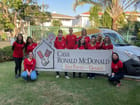The city of Austin didn’t just magically turn into the tech hotspot it is today. In fact, it was a deliberate endeavor that business experts planned years before the first major tech company ever broke ground within our city walls.
These individuals wanted to develop a job environment that didn’t depend on oil fields like other major Texas cities, while also making better use of major employers in town — like the University of Texas and the state government.
According to A History of High Tech and the Technopolis in Austin, the planning for the tech takeover began in 1957 when a group of private and public leaders developed the Austin Area Economic Development Foundation. Thus began a recruiting effort that specifically targeted manufacturing companies of electrical and scientific equipment.
Just like today, the group relied on a lower cost of living, tech talent and a higher quality of life to attract both business and talent.
One of the first to arrive was Tracor in 1962. Then came IBM in 1967, Texas Instruments in 1969, Motorola in 1974, the launch of UT’s IC² Institute in 1977, Microelectronics and Computer Consortium (MCC) in 1982, and Dell in 1984.
We caught up with representatives from a few of these companies — IBM and Motorola — to learn more about why the two companies chose Austin at the time and how they’ve evolved over time as the city’s tech scene matured.
Kevin Nowka, IBM’s state senior executive, shared the details on IBM’s first office in Austin. The plant was home to IBM’s Selectric typewriter (featured above) which had 2,800 parts to it. Today, IBM is our city’s third-largest employer, and second largest in digital tech.
Why did the company choose Austin in 1967?
IBM's Office Products Division was expanding at the time. The group decided to build a plant and engineering complex, dedicated to the Selectric typewriter, in Austin. After breaking ground in February of '67, the first Austin-built Selectric shipped on July 31.
Over the next three decades, the site evolved from office machines, including the IBM PC Convertible (the world's smallest laptop in 1986), to advanced circuit research and development, such as the first 1GHz multi-core chips in the late 1990s, and the Cell processor used in the PlayStation3 in the early 2000s.
What does IBM Austin do now?
IBM Austin is a microcosm of the entire company, unique in that every part of IBM is represented here. This includes IBM's headquarters for Design, established in 2013, as well as Research, Mobile, and Watson labs, covering everything from AI, to cloud computing and cybersecurity. For example, our Accessibility lab recently launched its Aging in Place environment to develop AI-powered technology to help our aging population stay independent, longer. And musicians from pop artists to Broadway composers are testing IBM Watson Beat as a creative composition assistant.
How has Austin continued to play a role in IBM's mission?
IBM is Austin's third-largest private employer and has included the acquisition of several local companies, including Tivoli Software, Lombardi, Gravitant, and others. As IBM's state senior executive, I can say that as we've entered each new era, we've been able to draw on the talent and creativity of state and local universities, as well as Austin's workforce. As an example of this drive to innovate, the IBMers in Austin have contributed more patents than any other businesses in the area.
Motorola came to Austin in 1974 to break into the semiconductor chip production business. The photo above, pulled from Motorola’s 1974 Annual Report, features “the new Austin, Texas facility dedicated to MOS integrated circuits production.” Upon launching one plant, four more quickly followed. And by the 90s, Motorola’s employment in Austin grew at more than 11,000 employees.
However, once the company entered the cell phone business, it broke off its semiconductor sector and renamed it as Freescale in 2004. Now Freescale is part of NXP, following its $12 billion acquisition of the company in 2015. Dawn McKenzie, head of North America PR for Motorola, sent over the 1973 press release when Motorola first announced that it would be heading to Austin.
On why Motorola chose Austin:
“I am extremely pleased to bring to this cultural and economic center of the Southwest Motorola’s highly sophisticated MOS integrated circuits operations,” said Jack Haenichen, VP and director of MOS integrated circuit operations at the time. “The technological intricacies of fabricating the equivalent of thousands of transistors and electronic components on an eyelash thin piece of silicon… requires employees who are a distinct cut above average.”
He continues, “In Austin, we found them, backed by also extremely attractive living conditions. Austin was an ideal selection for this newest and most advanced Motorola plant.”
On Motorola’s business strategy now:
“Today, Motorola Mobility focuses on the design and manufacture of smartphones,” said McKenzie.
Images by Neal Douglass from the Austin History Center, Motorola’s 1974 Annual Report and social media.
Have news to share? Let us know with a tip or on Twitter @BuiltInAustin






